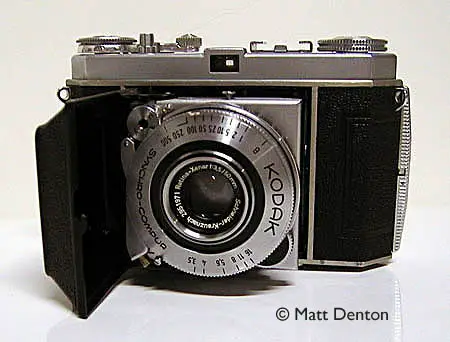- Produced 1951-54 type 015, 1934-69 all models; Kodak AG, Stuttgart, Germany
- Film type 135 (35mm)
- Picture size 24 x 36mm
- Weight 17.6oz (499g)
- Lens Schneider-Kreuznach Retina-Xenar 3.5/16 50mm (4 elements, 3 groups)
- Filter size looks like 22mm
- Focal range 1m to infinity
- Viewfinder viewfinder
- Exposure meter none
- Shutter Synchro-Compur
- Shutter speeds B, 1-1/500
- Self-timer
- Accessory shoe and PC sync connection
Overview
Classic, classic folding camera made in Germany by Kodak AG at the former Nagel Camerawerk factory (from whence came most of Kodak’s best cameras IMO). The long-lived Kodak Retina was distinctive for poplularizing the 35mm format: along with the original Retina (1934), Kodak released the revolutionary pre-loaded 35mm light-tight cassette that we take for granted now. Before that, photographers were expected to roll their own.
The venerable Retina came in so many flavors over its life that you could have a hobby collecting only Retinas (and some do!). For myself, I was simply looking for a small high-quality 35mm folder, and had been shopping for a Voightlander Vito II for a long time, but got frustrated waiting for a Compur-Rapid version (Prontor shutters ain’t the best) with an accessory shoe for my accessory rangefinder for a decent price. So I switched gears and got a sweet little Retina Ia instead.
To be sure, if you want real in-depth information on Retinas I suggest you follow the Links below, I only know what I know if you know what I mean. I can tell you that there are viewfinder-equipped Retinas and rangefinder-equipped Retinas, Retinas with Xenar, Xenon, and Ektar lenses, Compur-Rapid Retinas, Synchro-Compur Retinas, and Retinas with cream cheese on top. Not sure about that last one, but you get the picture. And I’m not even talking about Retinettes and Retina Reflexes!
Retinas are typed unspecifically as type I, Ia, II, IIa, etc., but specifically broken down into types to distinguish the distinctive model variations (types 011, 113, etc etc). This model is a Ia, aka type 015, and hails from the period 1951-54. It was the first with a rapid wind lever and has a host of other little features that were innovative at the time and seem to have shaped the design of many cameras that followed. It really is a sweet little camera, it’s got that tight german feel of precision and balance that you have to experience in person. A new favorite!
Repairs
Lens was slightly hazy, cleaned up with Windex, including unscrewing the front element and getting to the other element through the shutter on ‘B’. Cloudy viewfinder, I had to remove the wind lever and knob, both require a point spanner. Two screws on the side, and boy were they all on tight! Careful not to mess up the screw slots, use a same-size screwdriver. Yikes. Under the cap the viewfinder glass is actually covered with a cover that requires another screw be removed. And good thing I had this helpful page to refer to when reassembling the tricky wind lever/counter mechanism!
Tips & Tricks
It does have some quirks, I’ll hit the highlights here — nothing too hard to figure out if you’ve used any compact folders before. Button on top to release the lens cover, to close it you set to infinity (important) and push the two locking buttons on either side of the lens mount that run in the track. Back release catch is on the side, film release clutch button is on the bottom as on a modern camera. Rapid wind lever on this model is large and comfortable and springs back with gusto (or ‘flies back’ as the manual says). Rewind knob lifts up and turns, and has a film reminder wheel. X-M switch for instant/flash or bulb. Top-mounted shutter release (smooth!), none of this reach-around stuff… and even though it’s zone focus there’s a nice knurled tab on the lens mount to make focusing more comfortable (also smooth!). The only non-intuitive feature is the auto-frame counter, which counts backwards (!) and then locks the shutter release when it hits the last frame. Reset in the direction of the arrow (clockwise on this model) to 3 frames past the amount of exposures on your film cassette (designated by diamonds in the counter, but they don’t make 20-exp rolls any more), cock and fire three times and you’re good to go.
You may want to pick up an auxiliary rangefinder as a focus aid, just slip it into the accessory shoe and you’re set.
Related Links
- Kudos to Karen for her very nice Retina page
- Mike Elek has many cameras including several Retinas
- Chris Sherlock’s page is largely dedicated to Retinas and includes tips and teardown info
- Mischa Koning’s redo of Chris Eve’s old Kodak Pages has a Retina Section
- As does Walker Magnum in his own extensive Kodak collection pages
